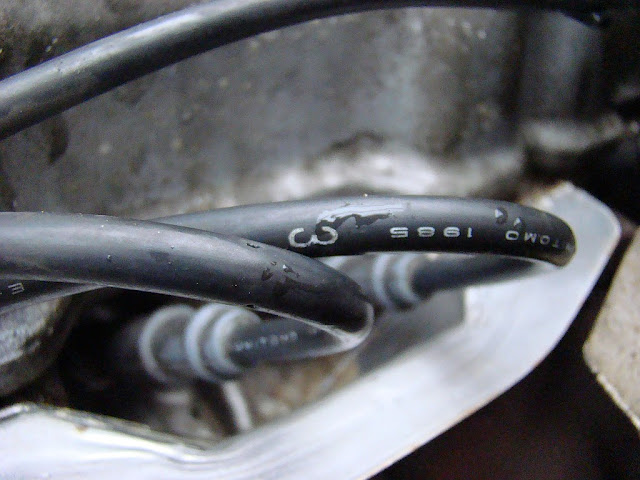Disassembling the head. But what exactly is "the head"?
It's the part shown in the following picture.
“The head” consists of several parts:
- the camshaft. This operates a number of levers (the "valve rockers")
that...
that...
- open and close the valves.
- these valves are in a "cover" that sits on top of the cylinder. This cover
is called the cylinder head.
is called the cylinder head.
Because this is a four cylinder engine there are four covers (cylinder heads) in a row, all in one metal housing..
Which is a little confusing, because this metal housing with the four cylinder heads is called "the head".
We're going to remove the complete head so we can get to the gasket between the "lower block" and the head. The lower block is the part that contains the cylinders and pistons.
You still with us? :-D
Good, then we can continue with the photo manual.
This is a top view of "the head".
Click a picture to see it full screen.
Click a picture to see it full screen.
The colors:
- yellow = the timing belt. We'll see that again later on;
- red = a valve rocker, which is basically a lever that opens and closes a valve.
- blue = two of the ten (actually eleven) head bolts. These are screwed straight through the head into the lower block.
- green = part of the camshaft. The cams move the rockers up and down.
A little more information, this makes it easier to understand what we're doing.
- yellow = the tube through which coolant flows from the radiator to the engine;
- blue = the fuel pump;
- green = the fuel pump's drive: a lever (to the left in the green part) that runs over a wheel which has an opening that's not in the center (for word puzzle lovers: eccentric :-)) This makes the arm move up and down, thus driving the fuel pump. Actually pretty simple, but also quite ingenious;
- red: the aforementioned timing belt.
Next step: disconnecting the three hoses from the fuel pump. All neatly labeled...
Get rid of the supply tube that connects the radiator to the engine.Unscrew and remove the tube clamp.
Take out the two bolts that connect the fuel pump to the head.
...the fuel pump and lever can now be removed.
As you can see, no more dirt can get under the nails. That space is already full ;-)
As you can see, no more dirt can get under the nails. That space is already full ;-)
...and this is what's left.
An interesting picture, because you can see the ultimate goal of our labor, the head gasket. This is the thin, black line you see in the red circle.But you also see:
- the fuel hoses are connected to the intake manifold, these stay connected to the head. The fuel lines must therefore be disconnected, which you can see in the yellow "circle";;
- the law of communicating vessels still applies, which is why coolant keeps dripping from the engine. This happens in nice, separate drops that you can see in the green area.
Now it's time to disconnect the bypass hose (in yellow): when there's no need for cooling, the coolant immediately flows back to the radiator..
To remove: unscrew the hose clamp and pull the tube off while twisting simultaneously.
The green part is the intake manifold.
And then we got tired of the coolant's constant dripping. So we drain it the LandCruiser way: open the tap and let it flow. Nice and simple.
Time to take a break and have a look at the joint packing. That's a lot.
And this is our "objet du désir" (object of desire): the new head gasket.
The accompanying description provides valuable information, including the cylinder diameter (92 mm), order in which the head bolts need to be tightened, and torque. More on that later.
Click the picture for a (very large) magnified view.
Meanwhile, there's still something in our way on the right side of the engine block: the power steering pump (in yellow). We'll have to take it off.
By unscrewing this bolt you can detach the pulley (= wheel with a notch for the V-belt on the outside) and move it to the right, so the V-belt that runs over it can be removed.
Then the bolts are removed from the power steering pump, and the pump can be taken out in its entirety.
This can be seen here.
Now it's the exhaust's turn. A manifold is attached to the right side of the head. Each cylinder has its own exhaust and the exhaust manifold turns the four pipes into one. This is the exhaust...
The exhaust manifold (the red part shows the connection to the head) is a little bit hot, so a sort of shield is placed in front of it: a heat shield (yellow).
The heat shield (yellow) is disconnected. The manifold is visible in all its glory.
By twisting the nuts off the manifold, you can pull the manifold forward. ---more next time---






























































